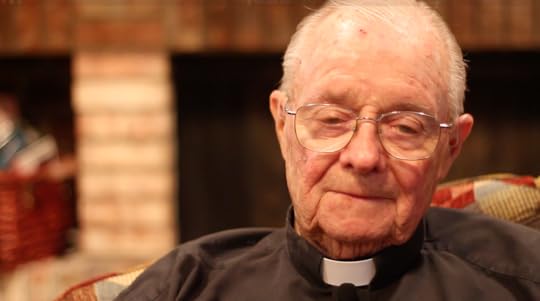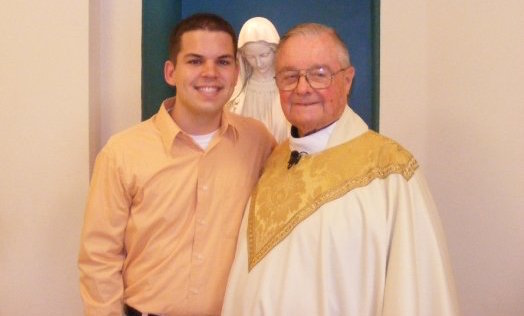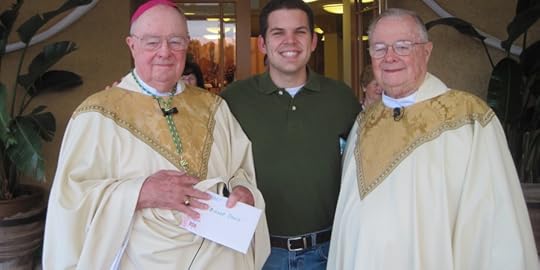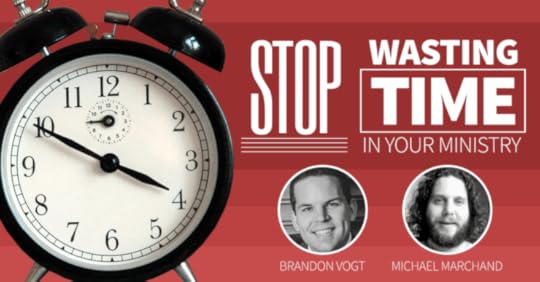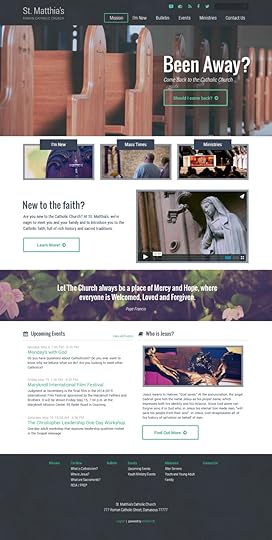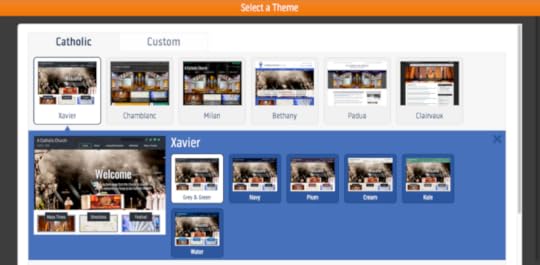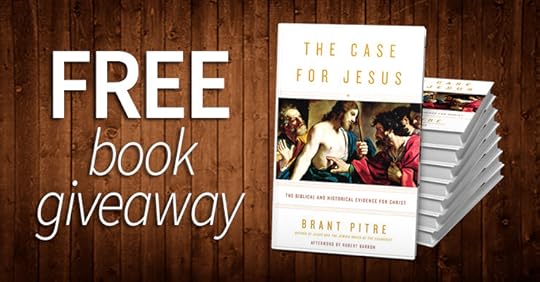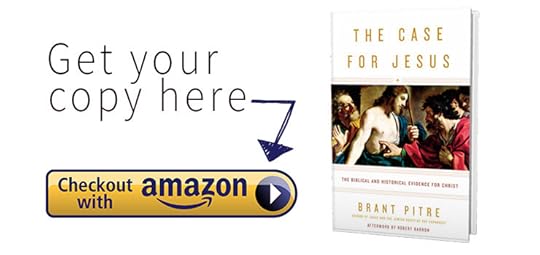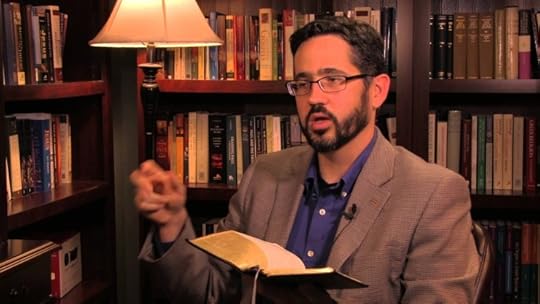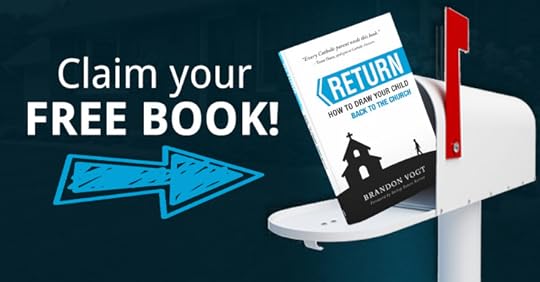Brandon Vogt's Blog, page 10
March 7, 2016
Learning from a Young Mother Martyr

Today we continue our regular series called “Learning from the Saints.” Our guide is expert Bert Ghezzi, a dear friend of mine and the author of numerous books including Voices of the Saints, Saints at Heart, and Discover Christ: Developing a Personal Relationship with Jesus.
His more recent books are The Power of Daily Mass and The Heart of Catholicism. You can learn more about Bert and his work at BertGhezzi.com.
Today, Bert profiles St. Perpetua.
St. Perpetua was a delightful young woman we would like to have known personally. Clear-headed, courageous and charming, she took control of every situation. Perpetua dazzled people with her pluck, and they would just let her have her way. And most remarkably, she was merry in the face of certain death.
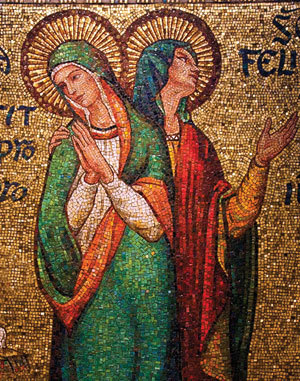 When Perpetua became a Christian she was only 22 years old and the mother of an infant son. Shortly after her conversion in 203, the Emperor Severus decreed a persecution in Rome. Perpetua, her friend Felicity and three others were arrested and held for trial. Her father, a good pagan, tried to persuade her to renounce her new faith. While Perpetua felt her dad’s suffering, she could not reject Christ.
When Perpetua became a Christian she was only 22 years old and the mother of an infant son. Shortly after her conversion in 203, the Emperor Severus decreed a persecution in Rome. Perpetua, her friend Felicity and three others were arrested and held for trial. Her father, a good pagan, tried to persuade her to renounce her new faith. While Perpetua felt her dad’s suffering, she could not reject Christ.
“Father,” she said, pointing to a water jug, “do you see this container? Can you call it by any other name than what it is—a jug?
“No,” he replied.
“And in the same way, I cannot call myself by any other name than what I am—a Christian.” Quivering with anger, he left in defeat.
You can imagine how Perpetua missed her baby and how she feared for his future. But her mother and brother, both Christians, brought him to her in prison, relieving her anguish. “I spoke anxiously to my mother about my son,” said Perpetua, “and encouraged my brother. I commended my son to their care.”
Perpetua and her companions were tried before an angry mob. All refused to worship the emperor as a god and so were condemned to death by fighting wild beasts. Then at the emperor’s birthday celebration, she and her companions were paraded into the arena, the crowd roaring for blood. An eyewitness gave this account:
“For Perpetua and Felicity, the devil had reserved a vicious cow. Perpetua was first thrown and landed on her side. When she sat up she noticed her dress had been torn, and she adjusted it to cover her thigh. Modesty was more on her mind than pain. And then she pinned up her disheveled hair because she didn’t think it was right for a martyr to appear to be grieving at the moment of glory. She stood up, and when she saw Felicity struck down, she went over and helped her up.”
At this point Perpetua and Felicity were moved from the field to an arena gate. The saint appeared to be dazed in an ecstasy, not even realizing that she had been gored.
“She did not believe she had been attacked until she saw the marks of mauling on her body and on her dress. Then she exhorted her brother and a catechumen, saying: ‘Stand fast in the faith, and love one another, and don’t take offense at our suffering.’”
Soldiers were ordered to finish the women off by slitting their throats. Perpetua shrieked as a nervous soldier, a novice, awkwardly struck her with his sword. Then this extraordinary young woman took charge of her own martyrdom.
“And when the soldier’s hand still wavered, she guided the sword to her own neck. Perhaps so great a woman,” wrote the eyewitness, “could not be dispatched unless she herself were willing.”
The witness gave spiritual motives for Perpetua’s demeanor in the arena. Modesty and glory, he said, caused her to cover her thigh and fix her hair after she was gored. Perhaps so, but I would rather attribute her behavior to the natural impulses of a twenty-two year old woman. Perpetua was classy, and I think she just wanted to look good in her final hour.
(Image Credit: Our Sunday Visitor)
Read more from Bert at his website www.BertGhezzi.com, or check out his many books on Amazon.
The post Learning from a Young Mother Martyr appeared first on Brandon Vogt.





February 24, 2016
Fr. Ed Thompson, Prodigal Priest and Father of Mercy
Last week, our family grieved the loss of Fr. Ed Thompson, a spiritual giant who had an enormous impact on our community. At age 92, he was the oldest active priest in the Diocese of Orlando.
But more than that, he was our priest. He served for over 20 years at our parish, St. Mary Magdalen in Altamonte Springs, FL, and was extremely close to our family: he married me and Kathleen, baptized our children, and served as my confessor and spiritual guide ever since I became Catholic in 2008. Two months after I entered the Church, he and I began meeting weekly for instruction, prayer, and spiritual conversation. We spent hundreds of hours together over the last eight years.
Fr. Ed’s story is a remarkable one, beginning with great success as a young priest and then spiraling into addiction and suspension from the priesthood. Yet through God’s grace, it’s ultimately a story of redemption.
Fr. Ed’s mother discovered she was pregnant in 1922, and the doctors were worried. She was already in delicate health, so when they learned she was pregnant with twins, they strongly urged her to abort the pregnancy, or at least one of the twins. They thought it would be too dangerous to continue full term, and warned that if she went through with it, she would likely either die (worst case) or suffer as a cripple for the rest of her life with rheumatoid arthritis (best case.)
Yet she refused their advice.
As it turns out, the doctors were correct in their prediction. After giving birth to Ed and David Thompson on May 29, 1923, in Philadelphia, PA, their mother indeed developed rheumatoid arthritis and suffered with it for the rest of her life.
When the boys were born, the arthritis had already become so bad that she couldn’t even hold the new babies. She was able to do one thing, though: as the nurse brought the boys near, their mother took their hands, one at a time, and helped them make the sign of the cross over their foreheads. (Fr. Ed would later see this as a foreshadowing of the thousands of priestly blessings he and his brother issued over the years.)
As the two boys grew, they became drawn to religious service. They decided to both enter the seminary, studying under great professors and falling under the influence of Archbishop Fulton Sheen. Sheen became their great hero and they were able to meet him on several occasions. Once, while the boys attended one of Sheen’s radio recordings, Sheen walked up to the twins, who were in seminary at the time, and said, “Seminarians! Future priests! TWINS!” Sheen then embraced the two boys, looked at them with his piercing eyes, and offered his advice: “Persevere. Persevere. Persevere.” How prescient that advice would become.
Fr. Ed was ordained a priest in 1951. Not long after, he became the director of vocations for the Archdiocese of Philadelphia, where his work remains legendary. Most dioceses today would be thrilled to ordain three or four guys each year. But as vocations director, Fr. Ed consistently guided scores of young men to the priesthood. One year, he saw over 100 men ordained from his diocese! For this extraordinary work, Fr. Ed was awarded the honorary title “Monsignor” (though he would always prefer to be called “Father”.)
As vocations director, one of Fr. Ed’s tasks was to organize a massive event celebrating the World Day of Prayer for Vocations, which was to be held in Philadelphia one particular year. His bishop told him that it was his job to pack out the cathedral. So Fr. Ed reached out to the most famous, magnetic person he knew, someone he was sure would draw a crowd: Archbishop Sheen.
Sheen had worked with Fr. Ed on retreats in the past, and graciously agreed to come. But Fr. Ed wasn’t done yet.
He wanted to make an even bigger splash, so he also wrote to a little Albanian nun halfway across the world, Mother Teresa of Calcutta, inviting her to come and speak, too. Surprisingly, she said she yes. She was already planning a trip to America and said she would be happy to squeeze in the prayer event.
Crowds poured in for the World Day of Prayer celebration. It spilled out into the streets and parks around the Philadelphia cathedral. In fact, Mother Teresa delivered her main message at Benjamin Franklin Parkway, near the famous Rocky statue at the stairs of the Philadelphia Museum of Art.
Before the event started, the speakers and organizers gathered for prayer in the cathedral sacristy. Fr. Ed remembers the experience of holding hands with two living saints: “We prayed together and I had Fulton Sheen’s hand in my right, and Mother Teresa’s hand in my left.”
By this time in his life, it seemed clear that the Holy Spirit had destined Fr. Ed for great things, perhaps even to become a bishop (as his twin brother became.) But the tide soon turned. On November 8, 1960, John F. Kennedy, an Irish Catholic, was elected President of the United States. Fr. Ed joined a few other priest friends at a local bar, to celebrate the election of America’s first Catholic president. He had a few drinks, perhaps one too many. Those drinks led to more the next day, and then the next. Soon, Fr. Ed couldn’t stop. His friends noticed him becoming more abrasive and unreliable. He missed events, snapped at his friends, and spent more and more time drinking. Though he wouldn’t admit it then, he was in serious trouble.
He was an alcoholic.
After several disturbing mishaps in Philadelphia, Fr. Ed was sent to a diocese in Nevada. He had more problems there. The bishop gave him many chances to reform himself, but finally gave up. He stripped Fr. Ed of all his priestly faculties, telling him, “You will never serve as a priest again.”
That devastating decision only pushed Fr. Ed closer to the bottle. He was depressed, hopeless, and saw no meaning in his life. Being a priest was everything to him, and now it had been taken away.
The drinking continued, as did his despair. He wanted to escape the addiction. He wanted to free himself. He wanted to return to the priesthood. But there was no light at the end of the tunnel.
The dark days blurred into one another, until one day, he received a surprising message. It came from a lady who lived in Florida. At first he didn’t recognize her name. Her letter explained that many years ago, when Fr. Ed was still an active priest in Philadelphia, the lady had confided that God spoke to her, and that he wanted her to live an austere, consecrated life, though not through a religious order. She shared the message with several priests and leaders in her parish, but nobody believed God had actually spoke to her. Most of them dismissed her and suggested she look for a good husband and just get married.
“But,” she wrote, “You listened to me. You believed me. And you believed in me. I never forgot that.” For the last several years, the woman had lived the consecrated single life to which she felt God called her. Then recently, out of the blue, she sensed another message from God: “Fr. Ed Thompson needs your help. You need to find him and contact him.” She didn’t know why Fr. Ed was in trouble—they hadn’t spoken for years—and she didn’t know how to reach him. She didn’t know how she could help. But she trusted the impulse and decided to act.
She contacted the Archdiocese of Philadelphia, and after several attempts, eventually learned that Fr. Ed had been removed from the active priesthood and was now somewhere in Nevada. She tracked him down and sent the message: “Fr. Ed, we haven’t spoken in years, and you probably don’t remember me. But you once believed in me. You helped me when nobody else would. Now I believe in you, and I want to help.”
When she learned of his alcoholism, she invited him to come to Florida, where she could host him in her house and help him get back on his feet. Although it was one of the most humbling experiences in his life, Fr. Ed swallowed his pride and accepted the offer.
Heading to Florida was an admission that he couldn’t find healing on his own. He needed help. He moved in with this middle-aged woman, who lived in an old house with a bunch of cats. Fr. Ed was no longer allowed to say Mass publicly, but he received special permission to say Mass, once a day, privately in his room. The cats were his only parishioners (he remembered them meowing during his homilies, “but whether in approval or disdain I never knew.”)
Fr. Ed slowly adjusted and found stability. He started showing up for daily Mass at St. Mary Magdalen, a nearby parish, but not as a priest. He just sat in the pews, quiet and reserved. It took a while before anyone discovered his past ministry. Once the truth came out, the parish pastor at the time, Fr. Paul Henry, was a bit surprised. It was strange to see a priest as young as Fr. Ed who was retired. So he reached out to Fr. Ed to learn his story.
Fr. Ed shared the details. Fr. Paul sensed a good and faithful heart, but a man who was still on the road to recovery; he detected the lingering effects of addiction. So he suggested Fr. Ed enter Alcoholics Anonymous (AA). Once again, Fr. Ed sucked up his pride, connected with a man in the parish who would serve as his sponsor, and signed up for AA.
AA was arduous, as it is for most addicts. But after many months, he became clean of alcohol and would never drink again (even his later Masses would be celebrated using special wine with minuscule traces of alcohol.)
After seeing his progress, Fr. Paul floated the idea of Fr. Ed perhaps returning to active ministry. Fr. Ed couldn’t believe it. The most depressing part of his alcoholism was that it stripped him of his purpose and identity as a priest. He wanted nothing more than to recover that, to say Mass, to hear confessions, to usher people into the Kingdom of God.
It would take a lot of work to restore his faculties. A group of bishops convened to discuss the case, including Fr. Ed’s brother (then a bishop in South Carolina), Fr. Ed’s former bishop in Nevada (who was leery of the idea, saying “I’ve been burned by Ed one too many times”), and the then-bishop of Orlando, Bishop Norbert Dorsey. After much debate and discussion, they reluctantly agreed that with the support and guidance of Fr. Paul, Fr. Ed could resume his ministry as an active priest at St. Mary Magdalen.
Fr. Ed was overjoyed. He got his priesthood back. It was one of the best days of his life—”Next to my baptism,” he would later say—and he would remember its anniversary each year. After a long, dark journey of depression, addiction, and hopelessness, he had finally found redemption. He now had meaning. He could now be, once again, what God had called him to: a priest to his people.
For the next 23 years, Fr. Ed served the community at St. Mary Magdalen with heroic devotion and vigor. His two great privileges, he would often say, were to offer Mass and impart forgiveness through Confession. He said Mass every single morning, with few exceptions, over those decades—over 8,000 Masses. He heard thousands of confessions and was a fixture in the confessional every Saturday afternoon. He’s still remembered in our parish as “Easy Ed,” not just for the simple but profound penances he assigned, but for his merciful approach. In many ways, his pastoral demeanor anticipated that of Pope Francis. He was a father of mercy who sought above all, in the pope’s words, to “heal the wounds, heal the wounds.”
Fr. Ed served as hospital chaplain, chaplain to the Knights of Columbus, and taught many classes on Scripture and faith formation. To say he was a beloved priest in our parish would be an understatement.
Although he overcame many health struggles and survived his twin brother and only sister, Betty, Fr. Ed passed away on February 11, 2016. His funeral was held Thursday night, and the church couldn’t even hold half the crowd. Thousands of attendees spilled over into our parish meeting hall, where the funeral was simulcast and which was also bursting at the seams.
The night before, the parish held a wake service for Fr. Ed, and a few parishioners were invited to reflect on his life and impact, including my wife, Kathleen, and me. Although the above story, remarkable in so many ways, captures his life in broad strokes, I offer my personal testimony below of how this great priest shaped my life in particular.
My story with Fr. Ed Thompson began and ended at his two favorite places in the world: the altar and the confessional.
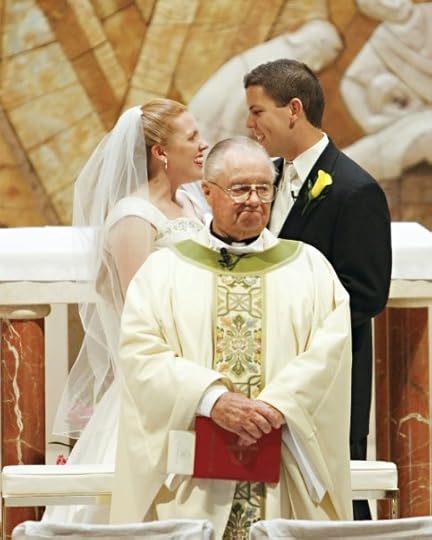 He stood at the altar on May 17, 2008, as he celebrated my and Kathleen’s wedding. A few months later, I mentioned to Kathleen that, as a fairly new Catholic (I had entered the Church just two months earlier), I wanted to study under a wise and holy Catholic, someone who could take me deeper in faith. Kathleen quickly replied, “Oh, you need to meet with Fr. Ed.”
He stood at the altar on May 17, 2008, as he celebrated my and Kathleen’s wedding. A few months later, I mentioned to Kathleen that, as a fairly new Catholic (I had entered the Church just two months earlier), I wanted to study under a wise and holy Catholic, someone who could take me deeper in faith. Kathleen quickly replied, “Oh, you need to meet with Fr. Ed.”
I asked Fr. Ed, and he agreed to meet. Over the next several years, we got together just about every week. We spent hundreds of hours together, and we talked about everything—God, the Church, Jesus, Mary, our vocations, and much more. Fr. Ed became my confessor, my spiritual guide, my confidant, and most of all, my friend—one of my closest friends.
It’s impossible to justly summarize such a rich friendship. But upon reflection, three things stand out to me. First, was Fr. Ed’s generosity. It was said about Fulton Sheen, Fr. Ed’s great hero, that you should never compliment anything in his house—or else he’d make you take it! One day, Sheen’s nieces were visiting when one of the young girls said, “Oh, what a nice lamp!” Next thing she knew, she was walking home with the lamp in her hands. Other people left Fulton Sheen’s house with wall paintings, vases, or statues.
Fr. Ed was just like that. Whenever I met with him, I learned quickly not to compliment or even comment on any of the books stacked around his shelf or his desk. This was hard, since we are both book lovers and we loved to discuss old books, new books, and whatever we were reading. But if I even said, “Oh, I heard great things about that book!” he would make me take it home. Even if I was able to keep my lips shut, he still sent me off with a handful of books. In fact—and I’m not kidding—on at least three occasions I departed with a black garbage bag full of books! Fr. Ed was one of the most detached people I have ever met. He knew, with assurance, that his treasures were stored up in heaven and that his possessions on earth were only passing, and because of that, he was open-handed with everything—his books, his money, his meals, and especially his time. He was the embodiment of self-gift. His life was a lesson for us, to let go of our possessions and see them only as tools or gifts for others.
A second thing that sticks out is Fr. Ed’s resolute focus on the One Thing, namely, knowing and loving Jesus Christ. Anyone who knew Fr. Ed, or heard him preach, will recognize this as his single, driving concern: to help others encounter Jesus Christ. For Fr. Ed, Jesus wasn’t just an interesting historical figure or a pious symbol. He was a real, living person, as alive as you, or me, or Fr. Charlie. While Fr. Ed knew Jesus as his Savior and Lord, he also knew him as his friend. And he spoke of him that way. He talked to Jesus, he sat with Jesus, he thought with Jesus. Fr. Ed once told me that the mission of his life was the same as Mary’s: to point others to Jesus—he wanted everyone to know Christ, and not just know about him (which is why his favorite book to recommend to people was Frank Sheed’s To Know Christ Jesus.) The philosopher Soren Kierkegaard said that a saint is someone “who is about one thing”. You could say that about Fr. Ed: he was about One Thing: knowing and loving Jesus, the Lord.
Finally, the lasting image I have of Fr. Ed is of mercy. I don’t think it’s a coincidence that God waited to take Fr. Ed into his glory until the Year of Mercy, which we’re celebrating right now. Anyone who saw Fr. Ed for confession knows he was a man of deep mercy.
My very last encounter with Fr. Ed came about 3-4 weeks ago, in the confessional he so loved. He was a fixture in that confessional for years, every Saturday afternoon. It was his favorite place to be. But this particular day was the last time he would ever hear confessions, and it was also the final time we would ever talk. I heard in his trembling, wavering voice, and I saw in his teary eyes, that he knew this would be our last meeting. And I sensed it, too.
The very last words Fr. Ed spoke to me were these: “I absolve you of all of your sins, in the name of the Father, and of the Son, and of the Holy Spirit.” And then he paused, looked me in the eyes, and said, “Brandon, God love you—I love you.” We embraced, we said goodbye, and that was it.
After I heard the news of his death, I thought, “How fitting—how fitting it was that the last words he spoke to me were words of forgiveness and love: ‘I absolve you of all of your sins’ and ‘I love you’.” How fitting because those last words of Fr. Ed to me were also the last two actions of Jesus on the Cross: forgiveness and love. Thus, Fr. Ed died in the same way as Jesus—in imitation of Christ, to quote another of his favorite books.
Knowing Fr. Ed as I did, I can think of no better words that he would want for his legacy than forgiveness and love, the two arms of mercy. That sums up Fr. Ed Thompson. He was a friend, he was a pastor, he was a spiritual giant, but maybe above all, he was a man of forgiveness and love, a man of deep mercy.
The post Fr. Ed Thompson, Prodigal Priest and Father of Mercy appeared first on Brandon Vogt.





February 18, 2016
FREE Webinar Training: How to Stop Wasting Time in Your Ministry (w/ bonuses!)
A few days ago I was talking to my friend Michael Marchand, who has worked as a Catholic youth minister for several years, when he told me a frustrating story.
It’s a story I hear ALL the time from people who serve at Catholic parishes, whether in ministries or on staff.
(And it will probably resonate with you!)
Back in 2006, Michael was hired full-time at his first parish. He was right out of college, full of ideas, and eager to jump into youth ministry.
He had these dreams of spending every day with teenagers: reaching new students, building relationships, hanging out at school lunches, grabbing ice cream after school, running Bible studies, leading retreats, and going on ski trips.
But then he hit reality:
No one told him about the amount of time he’d have to spend sitting at his desk.
No one told him about the administrative side of things.
No one told him how much time he would spend designing fliers and posters.
No one told him how many emails and voicemails from parents he’d have to return every day.
And no one told him how much energy those type of boring, mundane tasks would drain from him and his ministry.
There were tasks Michael was good at, and other tasks that he (admittedly) was really bad at. The tasks he was bad at were easy for him to hand off to other people – he learned to do that pretty early on.
But it was the (boring, mundane, administrative) tasks that he was good at that were the most time-consuming and draining.
For example:
Web Design – Michael had been designing and building websites since middle school. Back then he was even teaching his computer science teacher about how to write HTML code. It was easy to him and even fun a lot of the time. But the better he got at it, the more features he’d add – and the more time he would spend on it.
Graphic Design – Michael has a great eye for design and a love for Photoshop. His ministry always had the best fliers, posters, postcards and t-shirts. But he was spending hours each week creating them.
It took Michael a few years to realize it, but eventually he had an epiphany:
He was spending too much time on tasks that were RELATED to ministry but were NOT MINISTRY.
What made it even worse was that other people at his parish had noticed how good he was at these tasks, and they started asking him to help them design flyers, websites, and t-shirts.
Michael wanted to be a team player, so he always agreed to help. It was easier for him to do those things himself rather than “help them” to do them, so he just started agreeing to being in charge of things like web design, graphic design, the Sunday bulletin, social media accounts, video production, and more!
(Did I mention that Michael was hired to be the YOUTH MINISTER, and not the youth minister/bulletin designer/web host/communications director/video producer/graphic designer??)
Michael was spending more time doing tasks related to OTHER PEOPLE’S MINISTRY than he was spending time actually doing the ministry he was so excited about.
Now, I know Michael isn’t the only one with this problem. Earlier this week, I emailed my online followers and asked:
What tasks are you spending too much time on?
Hundreds of people responded, and the stories were mostly the same:
Ministry leaders everywhere are WASTING TIME…and they want to fix that.
Yet at least one thing comforts me: all of us, whether we work at a parish or serve in a ministry, seem to be wasting our time doing the same things.
Based on those hundreds of responses, here are the Top 6 Areas Where We’re Spending Too Much Time:
Managing registration, tracking payments, updating records, and keeping attendance.
Designing fliers, posters, and other graphics.
Updating the bulletin and website, or preparing bulletin announcements.
Managing and growing social media platforms.
Sending out email newsletters and replying to questions.
Dealing with technology issues (both ours and our coworkers’).
Here’s the thing: all of those areas are important.
They all have to get done.
But I’m guessing you never got into ministry so you could spend time doing the things on that list…right?
(I know I didn’t!)
So then I asked my online followers another question:
How many hours do you spend on those six time-wasting activities each week?
I was stunned.
The average answer to that question was 17.
17 hours.
People are wasting 17 hours a week doing things that may be RELATED to their ministry…but are not ministry.
I asked my friend Michael how much time he spent on these secondary tasks as a youth minister.
At his last parish, he realized that he was spending 4 hours EVERY DAY doing things like designing fliers, updating the website, writing bulletin announcements, managing registration, building social media campaigns, etc.
Yes, those are all important things, but that means he was spending 20 hours EVERY WEEK doing things that were not ministry – the thing he was called to do!
It took him years to realize this fact, but once he did, he was determined to fix the problem and his priorities.
And so he did.
And his solution was brilliant.
After a lot of trial and error, Michael figured out 4 keys to help him stop wasting all that time:
Strategy
Schedule
Systems
Services
When he shared his 4 keys with me, and told me more about each one, I was blown away.
Michael has now chiseled away most of the time he used to waste (while still getting those tasks done!) so that he is freed up to spend MOST of his week doing what he loved and was called to do!
Imagine how that would feel! Picture yourself not bogged down in mundane, boring, repetitive stuff every day and instead working on ministry projects that fulfill you!
When Michael shared about his 4 keys, I thought they were so genius, I asked if he’d be willing to share them with you.
I was able to convince Michael to join me for a live webinar during which we’ll break down these 4 strategies.
It’s a 100% FREE online event that we’ve created EXCLUSIVELY for people like you – people who want to save time so you can do more ministry and better serve the Church!
The webinar is next week and you can sign up at StopWastingTimeNow.com. Here are the details:
WHAT: FREE webinar training!
TITLE: “Stop Wasting Time In Your Ministry”
WHO: Brandon Vogt and Michael Marchand
WHEN: Tuesday, February 22 @ 2:00pm ET (1:00pm CT, 11:00am PT)
Just click here to register:
Click here to register for this FREE webinar!
In addition to the great free content, Michael and I will also be offering some great BONUSES to folks who join us LIVE on the webinar!
These include eBooks, PDF cheat sheets, recommended tools, and much more.
It’s going to be awesome! Can’t wait to see you there.
Last time I did a webinar, we had around 1,000 people sign up and we had a blast. So I want to make sure you claim your spot early and don’t miss it.
Just click below and then add it to your calendar:
Click here to register → Claim my spot in the free webinar!
See you on the webinar!
The post FREE Webinar Training: How to Stop Wasting Time in Your Ministry (w/ bonuses!) appeared first on Brandon Vogt.





February 17, 2016
What My Ideal Parish Website Looks Like (and How to Get It for FREE!)
In 2011, I published The Church and New Media. Since then I’ve spoken to thousands of Church leaders about the topic. I help lead the Digital Church Conference, I run online media for Bishop Barron and Word on Fire, and I’ve worked with several dioceses and parishes to solidify their new media strategy.
No matter where I go or who I speak with, this always seems to be a pressing questions:
Why are parish websites so bad and how can we fix that?
Most parishes know their website is important, but they don’t know how to make it great. They don’t know what the need, and (just as important) what they need to leave out.
When I get this question, I usually respond by noting that they should first follow general best practices for any website. So for example, parish websites should NOT have autoplay music, they should be clean and uncluttered, they should have clear navigation, they should have fresh, engaging content, and they should prioritize video and graphics over text. Those are all basic principles of good web design.
But what makes for a good Catholic parish website? What are the “must haves” for those particular sites, distinct from others?
A few months back, my friends at eCatholic, a web design service that wrestles with this question every day, approached me an idea. eCatholic is the largest Catholic website company in the world. They host and design websites for thousands of parishes. Their founder and CEO, Josh Simmons, is a good friend of mine, an expert speaker, and few people know more about parish websites than him.
So eCatholic had an idea for me:
What if you could design your ideal parish website?
You know about new media and evangelization, they said, and we know about building websites. What if we worked together to construct a parish website template that looked good and functioned well, one that truly carried forward the New Evangelization? If we could design the perfect parish website from the ground up, what would it look like?
They offered to design and code whatever dream website we created, for free, as long as they could offer it to all of their eCatholic customers for free, too. We would essentially build a customizable template that any parish could use to transform their online presence.
How awesome is that??
It was a no-brainer. I thought it was a brilliant idea, so we got to work. We spent several weeks scheming and planning. We surveyed the best parish websites out there and pulled in their top ideas and features. We cycled through several options.
Finally, we arrived at a website template that I think is going to help so many parishes.
Introducing the Xavier theme (named after St. Francis Xavier, arguably the greatest Catholic evangelist in history).
Here are some of the main features of the Xavier theme:
1. Built around the New Evangelization.
To me, this is critical. Most parish websites are designed for people already involved in the parish. They’re ad intra, to use Church language. They use insider language (e.g., R.C.I.A. or stewardship) instead of language that would be decipherable to someone who has been away from the church (or someone who has never been Catholic!). Similarly, the content and structure of most parish websites are clearly aimed at the already-involved.
But with the Xavier theme, the primary emphasis is on drawing back those who have been away. The first thing you see, in the giant image slider, is in invitation for fallen-away Catholics to return to the Church. Studies show that most people interested in considering (or reconsidering) the Church first head to Google. They search out nearby parishes, or Catholic websites, and make their decision based on what they find online. In other words, the parish website is often the first impression people have of your parish (and of the Church in general), whether the seekers be returning or new Catholics.
The Xavier theme makes sure that first impression is warm and welcoming. We want the 75% of people who no longer attend Mass each week to know that the main thing our parish cares about is welcoming them back so they can receive all the gifts God wants to give them through his Church.
That welcome starts with the invitation in the main image slider at top. It’s the first thing they’ll see: an invitation to return. But then further down, they’ll also find sections on “New to the faith?” (note: not “Sign up for RCIA”) and “Who is Jesus?”, both of which lead to a subpages with videos and resources from Bishop Barron on who Jesus is and why he matters. The goal is to be evangelistic and Christocentric, and I think we nailed it.
It’s worth noting that the theme doesn’t ignore the already-involved. They can still find everything they need via the menu structures. It’s just that the website doesn’t lead with content for the already-involved. It’s primarily aimed at those who have drifted away. In other words, it’s a website for the New Evangelization.
2. Clear navigation.
Many parishes are convinced they need to throw everything on their homepage. If it’s not on the homepage, they maintain, people will miss it. That’s why the average homepage has 84387972 links and announcements.
And I get that. Part of the problem is that every ministry thinks their events and news are top priority, so they demand to be featured on the homepage. But when you have 100+ ministries who think they’re Priority #1 and jostle for prime attention, nobody ends up prioritized. You just get a mess.
That’s why the Xavier theme features only three big call-to-action buttons on the homepage: “I’m New”, “Mass Times”, and a final one reserved for a single Big Event/Announcement/Feature.
After analyzing the data from thousands of parish websites, eCatholic has determined that, by far, the two most popular reasons people visit a parish website are to find Mass times and to learn more about the parish (who are you? what are you about? where you located?). So those two items should be front and center on every parish website—don’t make visitors hunt for them.
(The “I’m New” button also reinforces the point from the first feature above, that our parish cares, above all, about welcoming people who are new or who have been away a while. It’s our first priority. It suggests that we’ve taken time to create a specific page just for you, because you matter and we want to welcome you back.)
The third call-to-action button can highlight the One Big Thing going on in your parish this week (not the seven big things, not the three big things—the one thing.) Or you might choose to link to a particular ministry, sign-up page, or stewardship initiative from the button. Whatever the case, you can changes the images, headline text, and link to whatever you want. It’s completely flexible.
3. Great Catholic content, front and center.
This is probably my favorite part about eCatholic, in general. Every eCatholic website, regardless of the theme you choose, has built-in “content modules” that allow you to drag-and-drop great Catholic content anywhere on your website. The module then pulls in new content everyday…without you having to do a thing!
My favorite is the “Bishop Barron Video” module (surprise, surprise!). Drag that module to your homepage and you’ll automatically see Bishop Barron’s latest YouTube video on your parish website. You don’t have to know any code and you never have to update or touch it again. The module will automatically pull in new videos so your website constantly offers fresh, up-to-date Catholic content from one of our best teachers.
They also have modules for:
Mass Readings – Automatically pull in the daily Mass readings
Daily Lent/Advent reflections from Bishop Barron – In either English or Spanish!
Catholic News Service – The latest Church news from around the world
Vatican News – Updates on Pope Francis and the Vatican
National Catholic Register – Articles and blog posts from leading Catholic writers
Plus several more!
Here are a couple videos from eCatholic (not using the Xavier theme) which show you just how easy it is to add these content modules anywhere on your website:
4. Strong emphasis on videos and graphics.
You’ll notice that in the Xavier theme, there isn’t a lot of text on the homepage. This is intentional. Studies show that people spend much longer visiting video- and graphic-heavy sites rather than text-heavy ones.
To verify this, just think about the most popular sites on the Internet: Facebook, YouTube, ESPN, CNN. What do they all have in common? Lots of photos and videos.
Right out of the box, the Xavier theme comes with several photo and video widgets that you can customize however you like. There’s the big main image slider at the top, and there are places for a welcome video and quote graphic below.
Load in some of your own images, or choose from eCatholic’s free database of hundreds of Catholic images, and within just a few minutes, you’ll have a beautiful website that draws people in and keeps them hooked.
5. Mobile responsive.
Did you know that half of all online users access the internet exclusively through their phones? That percentage is only going up which means it’s crucial for your website to function well on any device.
The Xavier theme is mobile responsive, right out of the box. That means your site will automatically adjust to whatever device a visitor is using, whether a computer, a phone, or a tablet. The text, pictures, and video will resize accordingly, the menus will remain easily accessible, and visitors will have a consistently great experience regardless of their device—no pinching or zooming needed!
6. Several color and layout options.
Although the screenshot above is my favorite version of the Xavier theme, you’re not locked in to that layout. You have tons of flexibility with the look and feel of the site. You can choose from six color options and five layout styles—that’s 30 different possibilities!
Just to clarify, the Xavier theme is a template (one of many you get with eCatholic) which means that when you first activate it, it may not look exactly like the screenshot posted above. It will initially include default images, text, colors, and fonts inside the template. It’s certainly possible to make your site look exactly like my ideal site above by adding the exact photos and layout. But it’s better if you pop in your own photos and text, tweaking your site so it’s unique and personalized.
How to get the Xavier website theme?
As I mentioned above, if you’re one of the thousands of existing eCatholic customers, the template is already available in your template library! It’s free and you can start using it right away.
If you’re not an eCatholic customer, you get the theme free when you sign up for one of their hosting plans. Web designers would typically charge anywhere from $5,000 – $10,000 to design and code a site like this, but you can get it today when you join eCatholic for just $20, $35, or $50 per month, depending on the plan you choose.
The best way to sign up is to begin a free trial so you can play around with the template. If you don’t like it, no worries. You can cancel at any time during the first 30 days without spending a penny.
But I have a hunch that once you get into eCatholic and start using this awesome theme, you’ll quickly see how simple and elegant the service is.
You’ll discover what hundreds of parishes already know, that eCatholic will raise your ministry to the next level and ensure that the first impression people have of your parish is a great one.
Click here to start your free eCatholic trial!
(NOTE: If you sign up with eCatholic using any of the links above, I will earn a small commission. But I would promote eCatholic even if I didn’t earn a dime. I genuinely believe they’re the best website option for most Catholic parishes in the country. I’ve been using and recommending them for years.)
The post What My Ideal Parish Website Looks Like (and How to Get It for FREE!) appeared first on Brandon Vogt.





February 15, 2016
Learning from a Gentle and Joyful Evangelist

Today we continue our regular series called “Learning from the Saints.” Our guide is expert Bert Ghezzi, a dear friend of mine and the author of numerous books including Voices of the Saints, Saints at Heart, and Discover Christ: Developing a Personal Relationship with Jesus.
His more recent books are The Power of Daily Mass and The Heart of Catholicism. You can learn more about Bert and his work at BertGhezzi.com.
Today, Bert profiles Bl. Jordan of Saxony.
With hard-edged discipline and brilliant confrontation, St. Dominic established the Friars Preachers to proclaim the gospel and revitalize the Church. Blessed Jordan of Saxony, his successor, took a different tack to advance the work of the Dominicans. He used gentleness and charm to attract new members and expand the order throughout Europe. A divine hand seems to have arranged this succession, tapping the right man at the right time.
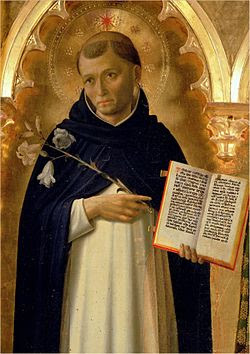 Jordan’s meteoric rise to head the Dominicans measures his exceptional leadership ability. Two months after he entered the order in 1220 he was one of a select group invited to participate in the first general chapter at Bologna. And just two years later, after Dominic’s death the community chose Jordan as its second master general.
Jordan’s meteoric rise to head the Dominicans measures his exceptional leadership ability. Two months after he entered the order in 1220 he was one of a select group invited to participate in the first general chapter at Bologna. And just two years later, after Dominic’s death the community chose Jordan as its second master general.
Sometimes called the first university chaplain, Jordan had a gift for evangelizing college-aged youth. When he preached at universities, he enthralled his hearers. He personally brought a thousand young men into the order, including St. Albert the Great. During his tenure, he sent friars throughout Germany, Switzerland and Denmark.
Following Dominic, Jordan believed that the prayer of contemplatives fueled the activism of the friars. So he fostered the development of the Dominican sisters who devoted themselves to intercession. He personally directed the spiritual career of Blessed Diana d’Andalò who headed a cloister in Bologna. Jordan’s fatherly letters to Diana have a lyrical charm. In the following selection, he exhorts her and her sisters to keep heaven in mind:
“Apply yourselves with all your might to the life of virtue and the practice of the godliness that the apostle says is profitable to all things (see 1 Tim 4:8). And do not work so much at bodily penances that can so easily exceed the limits of prudence and wisdom. Let your hearts be always filled with a burning desire for the blessed city of the saints in paradise, that glorious storeroom of perfect joy and gladness, that abode of light, radiant with the splendor of utter beauty, far exceeding the understanding of man: a realm truly divine, worthy to be the dwelling place of him who is created in the image and likeness of God (see Gn 1:26).
“Let the loving thought of the Bridegroom be constantly in your minds. And as his eyes are upon you, do all you can to make your beauty perfect before him. Rid yourselves of any stain or blemish however small that might sully it and offend his divine gaze. Let there be purity in your hearts and innocence in your lives. In all that you do, be of one mind and one heart, in peace and concord, in unshakable love, and in that loving humility that is the guardian of all good things. So that, while your souls find deep and lasting delight in the life of holiness, they may themselves be a source of delight to the Son of God who is blessed for ever and ever. Amen.”
Bd. Jordan wrote a life of St. Dominic that the main source of information about the founder and the early Dominicans. In 1237, while on the way to the Holy Land he and two friars died in a shipwreck off the coast of Syria.
Once when Jordan was at evening prayer with some novices, a fit of giggles broke out among the young men. An older brother gestured them to stop. Jordan asked the senior friar, “Who made you novice master?” Turning to the youths, he said, “Go ahead and laugh! Laugh all you want, for you have escaped from the devil, who used to hold you captive.”
(Image Credit: Nossa Senhora De Aparecida)
Read more from Bert at his website www.BertGhezzi.com, or check out his many books on Amazon.
The post Learning from a Gentle and Joyful Evangelist appeared first on Brandon Vogt.





February 9, 2016
[VIDEO] Make a Mess, Be a Fool, and Evangelize the World: Interview with Matthew Warner
Today I’m excited to interview one of my best friends, Matthew Warner.
He’s the founder and CEO of Flocknote, an innovative communication tool helping thousands of churches and dioceses better connect with their flocks.
He’s also one of the founders and speakers of the Digital Church Conference and a popular blogger and speaker.
Most excitedly, Matthew just released his first book, Messy and Foolish: How to Make a Mess, Be a Fool, and Evangelize the World, which was published by Matthew Kelly’s Dynamic Catholic.
What does it mean to “make a good mess,” as Pope Francis has encouraged? Why is it commendable to be holy fools? We discuss this and more in the video interview. Click below and enjoy!
Topics include:
1:21 – Matt’s viral online article, “Why the World Doesn’t Take Catholicism Seriously”
4:04 – What does it mean to “make a good mess”?
7:19 – How are we called to be fools?
11:40 – Where should we begin in order to evangelize the world?
The post [VIDEO] Make a Mess, Be a Fool, and Evangelize the World: Interview with Matthew Warner appeared first on Brandon Vogt.





February 8, 2016
[VIDEO] Bishop Barron, George Weigel, and….Jim Gaffigan on the Image of Divine Mercy
Check out this beautiful new film tracing the history of the Image of Divine Mercy. It includes interviews with many Church leaders, such as Bishop Robert Barron, George Weigel, and Cardinal Chistoph Schonborn.
But it also features big-name Catholic entertainers such as Jim Gaffigan and Harry Connick, Jr.
Part documentary, part devotional, and part treasure hunt, the film is now available to be screened at small and large venues internationally.
Learn more at DivineMercyFilm.com.
Parishes, schools, or event organizers can find more info about hosting a screening here.
The post [VIDEO] Bishop Barron, George Weigel, and….Jim Gaffigan on the Image of Divine Mercy appeared first on Brandon Vogt.





February 5, 2016
Book Giveaway (10 copies): “The Case for Jesus”
“Find out how much God has given you and from it take what you need; the remainder is needed by others.” — St. Augustine
Since I’ve built up a large collection of extra books and resources, every week I give some away absolutely free, no strings attached. Each giveaway lasts seven days with a new one beginning every Friday. You can enter any time during the week. Check out my past giveaways here.
Thanks to Random House, today I’m giving away TEN copies of Dr. Brant Pitre’s new book, The Case for Jesus: The Biblical and Historical Evidence for Christ. Learn more and enter below!
The Case for Jesus: The Biblical and Historical Evidence for Christ
by Dr. Brant Pitre
Image, 256 pages, hardcover
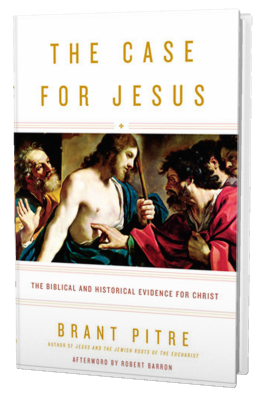 For well over a hundred years now, many scholars have questioned the historical truth of the Gospels, claiming that they were originally anonymous. Others have even argued that Jesus of Nazareth did not think he was God and never claimed to be divine.
For well over a hundred years now, many scholars have questioned the historical truth of the Gospels, claiming that they were originally anonymous. Others have even argued that Jesus of Nazareth did not think he was God and never claimed to be divine.
In The Case for Jesus, Dr. Brant Pitre, the bestselling author of Jesus and the Jewish Roots of the Eucharist, goes back to the sources—the biblical and historical evidence for Christ—in order to answer several key questions, including:
• Were the four Gospels really anonymous?
• Are the Gospels folklore? Or are they biographies?
• Were the four Gospels written too late to be reliable?
• What about the so-called “Lost Gospels,” such as “Q” and the Gospel of Thomas?
• Did Jesus claim to be God?
• Is Jesus divine in all four Gospels? Or only in John?
• Did Jesus fulfill the Jewish prophecies of the Messiah?
• Why was Jesus crucified?
• What is the evidence for the Resurrection?
As The Case for Jesus will show, recent discoveries in New Testament scholarship, as well as neglected evidence from ancient manuscripts and the early church fathers, together have the potential to pull the rug out from under a century of skepticism toward the traditional Gospels. Above all, Pitre shows how the divine claims of Jesus of Nazareth can only be understood by putting them in their ancient Jewish context.
I’m using Gleam to help with the giveaway, which is cool because it allows you multiple entries for posting on Facebook, sharing on Twitter, etc. Click below to enter:
(If you’re reading this through email or RSS and don’t see the giveaway widget, click here.)
By entering this giveaway you agree to occasionally receive email updates from me—no spam, just updates about free books, cool links, and exciting news.
The winner(s) will be randomly selected next Friday and the books will be sent out, free of charge, shortly thereafter.
In the future I’ll be giving away more books and resources, sometimes multiple items per giveaway! So subscribe via feed reader or email to ensure you never miss your chance to win.
(Since I’m covering the shipping costs, only residents within the continental United States are eligible to win.)
The post Book Giveaway (10 copies): “The Case for Jesus” appeared first on Brandon Vogt.





February 4, 2016
The Case for Jesus: Interview with Dr. Brant Pitre
**Interview originally posted at WordOnFire.org**
In his classic book, Mere Christianity, C.S. Lewis posed his famous trilemma: based on what we read in Scripture, Jesus Christ was either a liar, lunatic, or Lord. Anyone who said the things he said and did the things he did must either be a great deceiver (a liar), a confused or crazy man (a lunatic), or God himself.
However, for many modern skeptics, there’s a fourth alternative which Lewis didn’t include: legend. Perhaps we can’t trust the Biblical narratives about Jesus. Maybe they’ve been altered through the centuries much like an extended child’s game of “telephone.” And if that’s the case, we have no reliable information about who Jesus was or what he did.
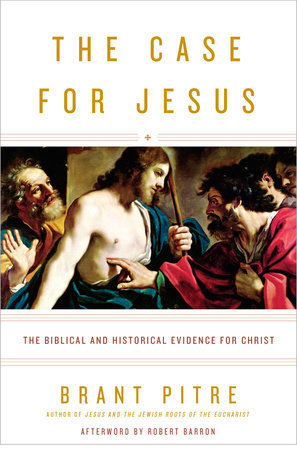 But is that really the case? Dr. Brant Pitre tackles many of these challenges in his newest book, The Case for Jesus: The Biblical and Historical Evidence for Christ (Image, 2016). Pitre, the bestselling author of Jesus and the Jewish Roots of the Eucharist, goes back to the sources—the biblical and historical evidence for Christ—in order to answer several key questions, including:
But is that really the case? Dr. Brant Pitre tackles many of these challenges in his newest book, The Case for Jesus: The Biblical and Historical Evidence for Christ (Image, 2016). Pitre, the bestselling author of Jesus and the Jewish Roots of the Eucharist, goes back to the sources—the biblical and historical evidence for Christ—in order to answer several key questions, including:
Were the four Gospels really anonymous?
Are the Gospels folklore? Or are they biographies?
Were the four Gospels written too late to be reliable?
What about the so-called “Lost Gospels,” such as “Q” and the Gospel of Thomas?
Did Jesus claim to be God?
Is Jesus divine in all four Gospels? Or only in John?
Did Jesus fulfill the Jewish prophecies of the Messiah?
Why was Jesus crucified?
What is the evidence for the Resurrection?
Today, I sit down with Dr. Pitre to discuss how recent discoveries in New Testament scholarship, as well as neglected evidence from ancient manuscripts and the early church fathers, together have the potential to pull the rug out from under a century of skepticism toward the traditional Gospels. Above all, Pitre shows how the divine claims of Jesus of Nazareth can only be understood by putting them in their ancient Jewish context.
BRANDON VOGT: Let’s start with a basic question: why this book and why now?
DR. PITRE: Because skepticism and confusion about Jesus and the origin of the Gospels is everywhere, and it’s spreading.
Over the years, I’ve lost count of how many times I’ve had people come up to me and tell me how they sent their sons and daughters off to college, only to have them come home agnostics or atheists. Over and over again I’ve been asked: Can you recommend a book for them?
Nor can I count the number of students I’ve taught over the years who’ve imbibed, from elsewhere, any number of historically unfounded claims about Jesus and the Gospels. It’s now standard fare for students to walk away from university classrooms thinking that that the Gospels were originally “anonymous”; that we have no idea who wrote them; that they certainly weren’t written by eyewitnesses; that the stories in the Gospels are like the end-product of an ancient “telephone game”; that the Gospels are more like “folklore” than biographies; that Jesus of Nazareth never actually claimed to be God; and that he only claims to be divine in the later Gospel of John—not the earlier Gospels of Matthew, Mark, and Luke.
I finally decided that the problem was so widespread that I needed to write something myself. So I did. I wrote The Case for Jesus for anyone—believer, unbeliever, or a little bit of both—who’s ever wondered: How did we get the Gospels? Who did Jesus claim to be? And why does it all matter?
BRANDON VOGT: As you say, many skeptics dismiss the Bible, thinking it’s little better than the “telephone game” played at kid’s parties, where a message is whispered from one ear to another and usually ends up completely garbled. If the Biblical testimony was passed down for many years before it was ever recorded in writing, how can it be trustworthy?
DR. PITRE: Well, to be frank, the four Gospels wouldn’t be reliable accounts if that’s how they were written. The whole point of the telephone game is to change the original story so that everyone gets a good laugh at the end.
The problem is of course that the telephone game analogy is completely anachronistic and simplistic—to say nothing of being academically irresponsible. It has no place in any serious book about Jesus. And yet it is still taught by skeptics everywhere as if it were a helpful analogy for how we got the Gospels.
To the contrary, as I show in The Case for Jesus, when you look at the actual historical evidence (instead of appealing to a ridiculous modern-day children’s game), you’ll find something quite different: you will discover that the four Gospels are in fact ancient Greco-Roman biographies, based on the eyewitness testimony of Jesus’ students and their followers, and written within the lifetime of the apostles. You’ll also see some of the striking differences between the four first-century Gospels and the so-called “lost Gospels”—such as the Gospel of Thomas or the Gospel of Judas—and why these later texts are not reliable sources for the life of Jesus.
BRANDON VOGT: Agnostic scholar Bart Ehrman claims that all four Gospels were originally published without any headings or titles identifying the authors, and that it was years later—perhaps more than a century—when Christians added the names Matthew, Mark, Luke, and John in an attempt to give the manuscripts more authority. Ehrman concludes that because we don’t know the original authors, we can’t be sure the Gospels contain reliable, eyewitness testimony from people who actually knew Jesus and his disciples. Is there anything wrong with this “theory of the anonymous Gospels”?
DR. PITRE: Yes. My book begins by taking the reader step-by-step through the serious difficulties with the now widespread theory that the Gospels were originally anonymous.
First problem: no anonymous manuscripts of the Gospels have ever been found. The reason? They don’t exist. That’s a big problem for anyone who wants to claim that “originally” they were anonymous. History is supposed to work with actual evidence.
Second problem: the idea that all four Gospels circulated anonymously for almost a century before somehow miraculously being attributed to exactly the same authors by scribes spread throughout the Roman empire is completely incredible.
Finally, if you were going to falsely attribute your anonymous Gospel to an author in order to give it “authority,” then why would you choose Mark and Luke, neither of whom was an eyewitness to Jesus? If authority is what you were after, why not attribute your anonymous Gospel to Peter, or Andrew, or for that matter, Jesus himself?
As I try to show, the theory of the anonymous Gospels is both unhistorical (it has no actual text-critical manuscript evidence to support it) and uncritical (it doesn’t stand up to logical scrutiny).
BRANDON VOGT: How can we be sure that Jesus was the long-awaited Messiah in Israel? We know of other historical figures who claimed the same thing. So what’s special about Jesus’ claim?
DR. PITRE: This is a great question. One of my other favorite chapters in the book is where I show why the earliest Christians—who were all Jewish Christians—came to believe that Jesus of Nazareth was in fact he long-awaited Jewish Messiah.
In large part, the answer revolves around Jesus’ two favorite expressions: “the Kingdom of God” and the “Son of Man.” As I show in the book, both of these expressions are drawn directly from the book of Daniel. Significantly, Daniel’s prophecies were interpreted by first-century Jews as not only foretelling the coming of the Messiah, but as actually giving a timeline for when he would arrive.
I can’t go into the details here, but if you get the book you’ll see that the prophecies in Daniel suggested to ancient Jews that the Messiah would actually come sometime in the first century, during the time of the Roman empire. In the midst of this fervent messianic expectation steps Jesus of Nazareth, who identifies himself with the Danielic “Son of Man” and the “Kingdom of God” and whose very death will take place at the time that Daniel says a future “messiah” would be killed.
Whenever I share this information with my students, they are often blown away. Most modern-day Christians are almost completely unaware that the book of Daniel even gives a timeline for the coming of the Messiah, much less how Jesus’ life fits into it. However, this was widely known by ancient Christians and one of their favorite arguments for showing that Jesus didn’t just claim to be the Messiah; he was actually “pre-announced” and fulfilled the messianic timetable given in the book of Daniel
BRANDON VOGT: Some scholars say that although Jesus may have been the Messiah, he never claimed to be God (except, perhaps, in the Gospel of John which, they assert, was written much later than the other Gospels and is thus unreliable). But is this true? Did Jesus think he was God? Is this evident in Matthew, Mark, or Luke, or elsewhere outside of John?
DR. PITRE: The question of whether or not Jesus claimed to be God is really at the heart of the book.
These days, it’s standard fare for skeptics to argue that Jesus is only depicted as divine in the Gospel of John and that he never makes any divine claims in the Synoptic Gospels of Matthew, Mark, and Luke.
This remarkably widespread idea is, to be frank, demonstrably false. As I show in the book, Jesus does indeed claim to be divine in Matthew, Mark, and Luke. But he does so in a very Jewish way: using riddles, parables, and allusions to the Jewish Scriptures (that is, the Old Testament) to both reveal and conceal his identity. However, if you don’t know your Old Testament well—and let’s face it, many contemporary readers don’t—then you won’t see it. You won’t understand clearly what Jesus is saying about himself and who he is really claiming to be. In other words, many people (including some scholars) miss the Jewish roots of Jesus’ divinity.
Indeed, as you will see if you read the book, if you want to deny that Jesus claims to be divine in the Synoptic Gospels, then you had better be ready to eliminate a lot of evidence. To be sure, Jesus is fully human in the Synoptic Gospels—but he is also much more than just a man.
BRANDON VOGT: There has been much debate among Bible scholars about what the early Christians meant when they claimed Jesus had been “resurrected.” What did they not mean by that idea, and what did they mean?
DR. PITRE: Well, when the Jewish disciples claimed Jesus was raised from the dead, they were certainly notclaiming that he had simply been resuscitated, or that his “spirit” lived on in the hearts of his followers, or that his “soul” had “gone to heaven” after he died. That’s just not what “resurrection” meant in a first-century Jewish context.
Instead, what they were claiming was that Jesus was now alive again in the same body that had been crucified, and that he would never die again. In other words, they didn’t go around preaching the immortality of Jesus’ soul; they proclaimed the resurrection of his body.
From the beginning, the bodily resurrection of Jesus was one of the most controversial claims made by Jesus’ disciples. In the final chapters of the book, I take a close look at the actual evidence the empty tomb and the bodily resurrection. (This makes it a perfect book for Lent and Easter!) But I also do something unique. Most books ignore the primary reason that the first Jewish Christians believed in the resurrection: they saw it as a fulfillment of Scripture. I try to show which prophecies from the Old Testament they believed Jesus had fulfilled and why the argument from Jewish Scripture was such a powerful motive of credibility for believing in the Resurrection.
BRANDON VOGT: Suppose you meet a Catholic college student who has sat through a few Introduction to New Testament lectures and is now reeling. The professor planted in his mind the seeds of skepticism, causing him to doubt his faith, the Scriptures, and even Jesus himself. What would you say?
DR. PITRE: That’s easy. I would tell them to read The Case for Jesus!
But seriously—I would first ask the student if he could briefly explain the arguments both for and against the truth of the Gospels and the divinity of Jesus. In my experience, students who have been shaken by skeptical scholarship almost invariably have often only heard one side of the argument.
That, at least, is what happened to me when I first began studying the historical debates over how we got the Gospels and who Jesus claimed to be. Almost twenty years ago now, I went through a very dark period where I almost lost my faith (more about that in the book). I was exposed to the more skeptical arguments, but was unaware of any of the counter evidence—the manuscripts of the Gospels, the evidence from the early church fathers, the Jewish meaning of Jesus’ divine claims in the Synoptic Gospels, etc.
In the final analysis, that’s why I wrote The Case for Jesus. I wanted to put all of the key issues on the table in a readable book, give people both sides of the argument, and let them judge the evidence for themselves.
The post The Case for Jesus: Interview with Dr. Brant Pitre appeared first on Brandon Vogt.





February 3, 2016
Can I mail you a FREE paperback copy of my new book?
I know you’re busy, so I’ll cut to the chase:
I want to mail you a FREE paperback copy of my latest book, RETURN: How to Draw Your Child Back to the Church.
Just click here and tell me where to ship it: http://FreeReturnBook.com
This isn’t an eBook.
This isn’t a PDF download.
This is a real, 256-page, paperback book.
And I want to mail it to you for FREE.
All I ask is that you cover the shipping and handling, which is $4.99 anywhere in the United States….that way I won’t be out thousands and thousands of dollars in shipping fees 
(Sorry international friends, but right now, this free book special is only available for U.S. residents.)
To claim your FREE copy of the book, just click here:
Click here → Send my FREE paperback copy of RETURN
When I wrote RETURN, my primary goal was to help as many parents/grandparents as possible.
I’ve heard the stories. I feel their pain. I know how helpless and hopeless they feel about sons and daughters who have left the Church.
That’s why I created RETURN: to give them the help and hope they need.
The full RETURN project includes a dynamic 16-part video course, a series of 10 interviews with Catholic experts (Master Series), a collection of bonus DVDs, books, and CDs, and more, in addition to the paperback book, which I’m giving away here.
Altogether, RETURN contains the best tips and strategies to draw a young person back to the Faith.
(If you’re interested in getting all of the RETURN resources, and not just the paperback book, visit ReturnGameplan.com)
It’s not a formula. And it’s not a guarantee that a young person will return.
But RETURN will put you in the best position possible to help them come back to the Church. It will increase the odds dramatically.
So please visit http://FreeReturnBook.com and claim your copy before I run out of books and this limited deal ends.
Enjoy the book!
PS. If this book can’t help you, I’m SURE it can help someone else you know. Maybe it’s a friend, a family member, a priest, or someone else at your parish. Claim a free copy for them! Or better yet, point them to this website so they can get their FREE book, too: http://FreeReturnBook.com
The post Can I mail you a FREE paperback copy of my new book? appeared first on Brandon Vogt.





Brandon Vogt's Blog
- Brandon Vogt's profile
- 75 followers


